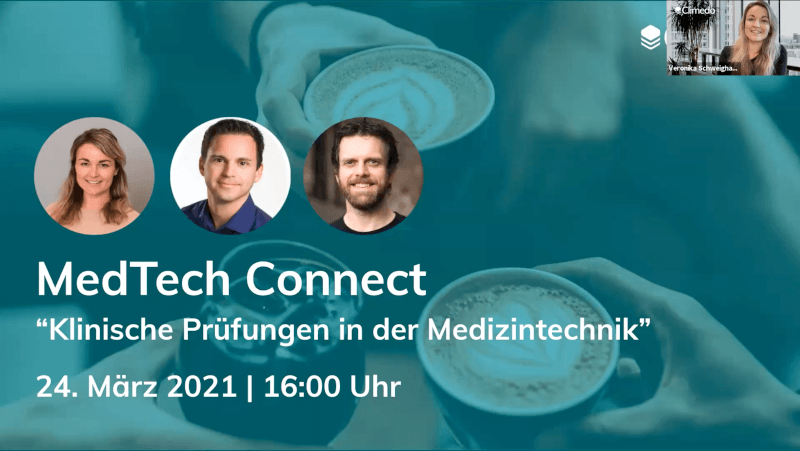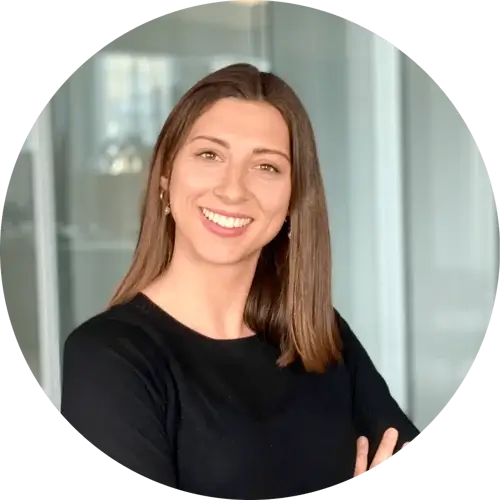MedTech Connect: Clinical Investigations for Medical Devices

DATE
March 25, 2021
AUTHOR
Kristina Weber | Product Lead
Please note that this event took place in German.
Our first #MedTechConnect event took place this week and we were thrilled to have so many attendees from the medical device industry with us! Around 75 guests gathered for the online meetup on March 24 at 4pm CET to discuss clinical trials for medical device manufacturers.
What was MedTech Connect about?
As a manufacturer, how do I know if and when I need a clinical study? And what type of clinical study does it need to be? What kind of challenges should I expect in this context and how do I tackle them?
These and other questions tend to keep many medical device manufacturers awake at night – whether they’re facing their very first clinical trial or need to collect data on products which have already been taken to market.
In this informal meet-up, Climedo Health, Curedatis and eye2you offered two exciting keynote speeches as well as a space to share specific experiences, questions and problems and to network with other manufacturers and experts.
Who were the speakers?
In addition to Veronika Schweighart, who hosted the event, Robert Radloff from Curedatis and Dr. Jörn-Philipp Lies from eye2you were also present.
As Co-Founder of Climedo Health, Veronika Schweighart accompanies clients from the medical technology sector on their way to successful electronic data collection in the context of clinical trials and PMCF.
Robert Radloff is a biologist and former clinical monitor for drug and medical device studies. As founder of Curedatis, he supports medical device and DiGA (digital health apps) manufacturers on their path to automated evidence synthesis.
Philipp Lies is a neuroscientist and former consultant. With his startup eye2you, he has spent the past two works working towards the vision of preventing unnecessary blindness worldwide. To this end, they are developing a smartphone software as a class IIa medical device.
Keynote 1: “When do I need a clinical investigation for a medical device?”
Following a short intro by Veronika Schweighart, Robert Radloff used specific examples to show which questions manufacturers should ask themselves when they need a clinical study or want to find out whether a study is even necessary. Here are some of the guiding questions to help manufacturers assess:
- What risk class is the product assigned to?
- What is its level of innovation?
- Is there existing clinical evidence on the product or a similar product?
- What stage of development and regulatory status is the product in?
- Are there open questions and residual risks associated with the product?
In a live poll, Robert Radloff asked participants what they thought was the biggest opportunity in clinical trials, besides regulatory compliance. “Obtaining user and patient feedback” (45%) was cited in first place, followed by “generating claims” (24%) in second place and “building reputation (21%) in third.
Using a new flowchart, Robert Radloff then ran through concrete scenarios and decision paths for different product classes. The complete flowchart will be published shortly.
Keynote 2: “Challenges for conducting clinical trials – a practical example”
This was followed by the second keynote speech by Jörn-Philipp Lies. As a manufacturer of a class IIa software product, eye2you has faced various challenges. Philipp Lies explained how, due to digitalization, more and more solutions come from IT and not directly from medicine and how awareness for clinical trials has to be developed first in many cases. In addition, he emphasized the need to be clear early on about the goals of the study. The various goals can include:
- Validity: Does our idea work at all; the actual quality is secondary here.
- Functionality: Do we deliver what we want? Are we better than the competition?
- Safety: Could the product pose a danger to patients and users?
- Usability: Is it intuitive to use and does it prevent misuse?
- Patient benefit: How much better do patients feel as a result of our solution (especially DiGa)?
- Marketing: Convincing customers (physicians, patients, health insurers, …)
This question was posed to the audience, which saw “safety” as the first priority when it comes to the core objectives of a clinical trial.
In the next step, once a decision has been made on the type of study needed, costs should be estimated, partners identified and patients found for the trial.
Finally, Philipp Lies shared a few practical tips from his own experience:
- Use existing evidence to plan trials efficiently.
- Find partners who are willing to donate their time and resources for scientific results (this tends to be much easier with modern technologies such as SaMD, AI, etc.)
- Networking with other companies
- See studies as a value-adding part of the product, not as a bureaucratic-regulatory requirement
Afterwards, there were numerous questions and impulses from the audience, which our speakers addressed. We would have liked to have had a longer discussion, but there wasn’t quite enough time. Maybe we will extend the session to 90 minutes in the future! 🙂
Watch MedTech Connect presentations as video recording
If you were unable to attend MedTech Connect but would still like to watch the presentations, you can request the link to the video recording here (in German).
About Curedatis
Curedatis is a startup that digitizes and automates the clinical evidence process to help medical device, in vitro diagnostics, and digital health companies meet the requirements for sufficient clinical evidence under the MDR, IVDR, and DiGAV. Learn more: www.curedatis.com
About eye2you
Eye2you is a medical AI company that enables primary care physicians and nurses to perform retinal examinations. All they need is a standard mobile funduscope, a smartphone, and the eye2you retinal analysis AI. This makes retinal exams cheaper, faster and more widely available. This helps to detect sight-threatening diseases like diabetic retinopathy or glaucoma before it is too late: www.eye2you.ai.







